January 29, 2020 / Hunan Provincial People’s Hospital, etc. / Oxidative Medicine and Cellular Longevity
Text/Wu Tingyao
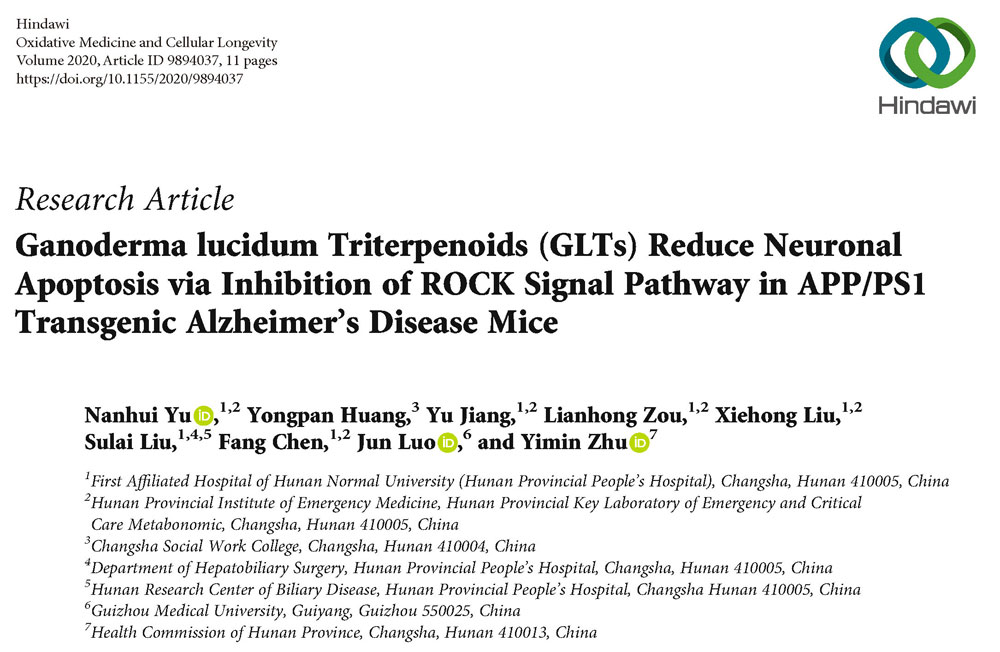
A study published in “Oxidative Medicine and Cellular Longevity” by Hunan Provincial People’s Hospital and Hunan Provincial Key Laboratory of Emergency and Critical Care Metabonomic pointed out that Ganoderma lucidum triterpenoids(GLTs) can protect brain nerve cells and reduce cognitive impairment caused by Alzheimer’s disease (AD) through mechanisms such as anti-apoptosis, anti-oxidation, and anti-neurofibrillary tangles.
Ganoderma lucidum triterpenoids delay cognitive decline in patients with Alzheimer’s disease.
First, researchers fed Ganoderma lucidum triterpenoids (GLTs) to Alzheimer’s disease (AD) mice that had developed early symptoms. After 60 days, they tested the cognitive abilities of the mice with Morris Water Maze (MWM).
Taking advantage of the characteristics of mice that naturally hate water and always try to find a place to avoid water, the researchers conducted Morris Water Maze, which is to set up a resting platform in a large circular pool to calculate the distance the mice swim and the time they spend in finding the resting platform as indexes to judge the cognitive abilities of mice. If the mice have been unable to find the resting platform (in two minutes), the researchers will help guide the mice to the platform.
Although the starting point for entering the water is different each time, normal mice can still quickly find the resting platform through day-to-day experience. Such an experiment was conducted once a day for a total of nine days. Calculating all the scores on average, the researchers found that AD mice (AD Group) must spend twice as long as or swim three-quarters longer than normal mice (control group) to find a resting platform, which indicates that the cognitive function of the brain of AD mice is significantly degraded.
However, AD mice fed with high doses (1.4g/kg per day) of GLTs took almost the same time and swimming distance to find the resting platform as the normal mice and the AD mice (Western medicine control group) fed with donepezil every day (Figure 1~2).
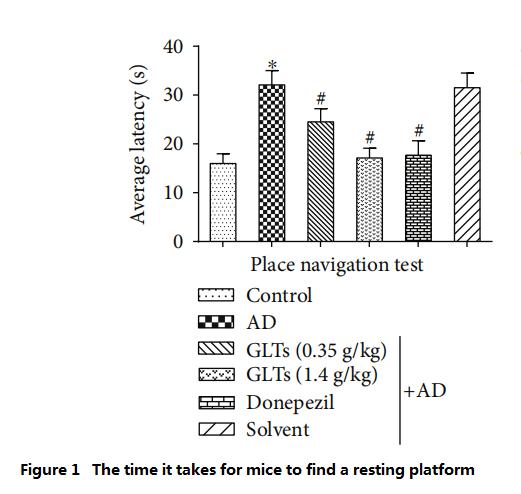
(The less time required, the better the cognitive ability)
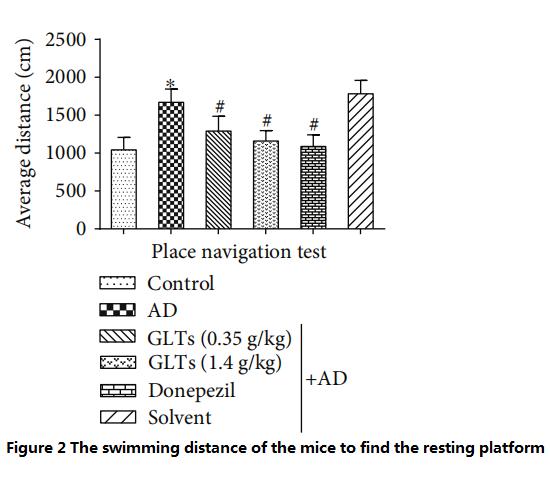
(The less distance required, the better the cognitive ability)
The next day after the end of the above experiment, the researchers removed the resting platform in the pool and put the mice in the water for two minutes.
Due to the previous nine days of experience, normal mice remembered the original location of the platform and spent more time swimming around the original location to look for the “disappearing platform” while Alzheimer’s mice swam goallessly.
In contrast, Alzheimer’s mice protected by GLTs behaved more like normal mice either at low doses (0.35 g/kg per day) or high doses (1.4 g/kg per day) and scored almost the same as those MD mice fed with western medicine (Figures 3 to 4).
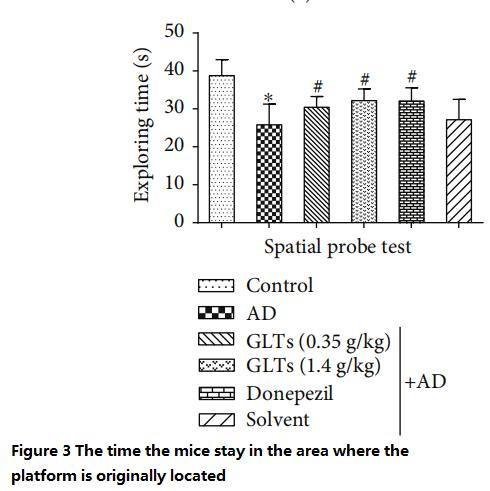
(The longer the stay, the better the cognitive ability)
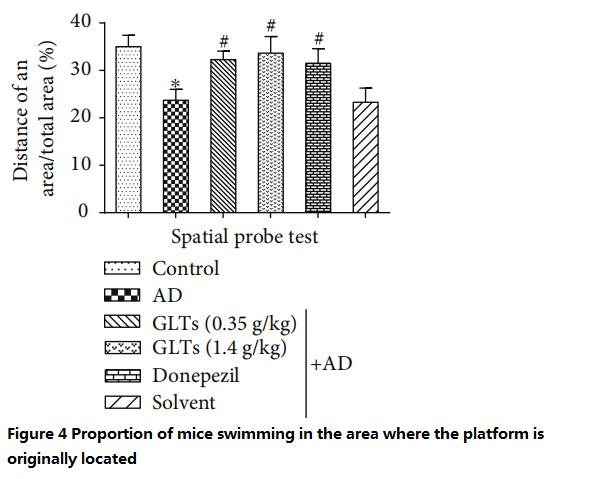
(The higher the proportion, the better the cognitive ability)
Ganoderma lucidum triterpenoids maintain the integrity of nerve cells.
Decreased learning and memory ability is the earliest cognitive function decline (disorder) in patients with Alzheimer’s disease, and the nerve cells in charge of this function are located in the hippocampal gyrus. Therefore, after the researchers completed the above experiments, they dissected the mouse brain for further examination.
The results showed that the nerve cells in the hippocampal gyrus of normal mice are neatly arranged, uniform in size, regular in appearance, and their cell membranes and nuclei are clearly demarcated; the nerve cells in the hippocampal gyrus of AD mice are disorderly arranged, different in sizes, irregular in appearance, drastically reduced in number, and its structure is obviously damaged.
However, this situation did not appear in AD mice consuming Ganoderma lucidum triterpenoids. The neuronal cells in their hippocampal gyrus still maintained a high degree of integrity, and there was no obvious cell necrosis, indicating that Ganoderma lucidum triterpenoids had a protective effect on the hippocampal gyrus ( Figure 5).
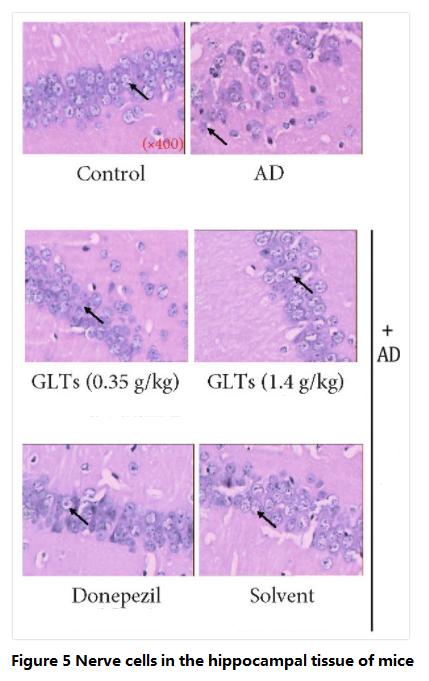
Ganoderma lucidum triterpenoids reduce neurofibrillary tangles.
At the same time, the researchers also found that the number of neurofibrillary tangles in the cerebral cortex (storing long-term memory) and hippocampal gyrus tissue in AD mice protected by Ganoderma lucidum triterpenoids was significantly lower than that in untreated AD mice (Figure 6).
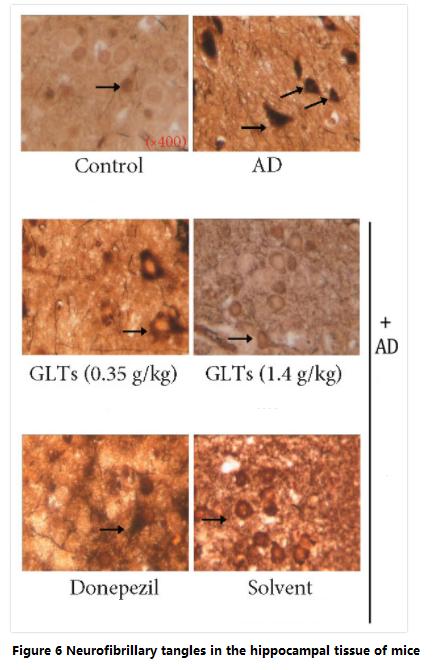
Neurofibrillary tangles are one of the main symptoms of Alzheimer’s disease. Unlike amyloid deposits that occur outside the cells, neurofibrillary tangles occur in nerve cells due to the mutation of “tau protein”.
Under normal circumstances, tau protein binds to the cytoskeleton (microtubules) to help the formation and stability of the cytoskeleton. However, the tau protein in the brain of patients with Alzheimer’s disease will mutate and cannot bind to the cytoskeleton. As a result, the tau protein will aggregate into clusters to form so-called “neurofibrillary tangles”, which accumulate in the cells and interfere with the function of cells. The cytoskeleton lacking the tao protein will gradually become distorted and disintegrated, leading to cell death.
The number of neurofibrillary tangles reflects the degree of deterioration of Alzheimer’s disease. Therefore, Ganoderma lucidum triterpenoids can inhibit the formation of neurofibrillary tangles, which should be one of the important mechanisms for Ganoderma lucidum triterpenoids to delay cognitive decline in Alzheimer’s disease.
Ganoderma lucidum triterpenoids reduce nerve cell apoptosis.
Either β-amyloid deposition or neurofibrillary tangles will initiate the suicide program of the cell and promote the apoptosis of nerve cells. As more nerve cells die, more functions are lost, and the cognitive decline caused by Alzheimer’s disease becomes more severe.
From the analysis of the hippocampal gyrus tissue of each group of experimental mice, it can be found that the death rate of nerve cells in AD mice is more than four times that of normal mice of the same age; although high-dose Ganoderma lucidum triterpenoids cannot completely prevent abnormal apoptosis of nerve cells, they have been able to halve the damage, and the effect is comparable to that of western medicine (Figure 7).
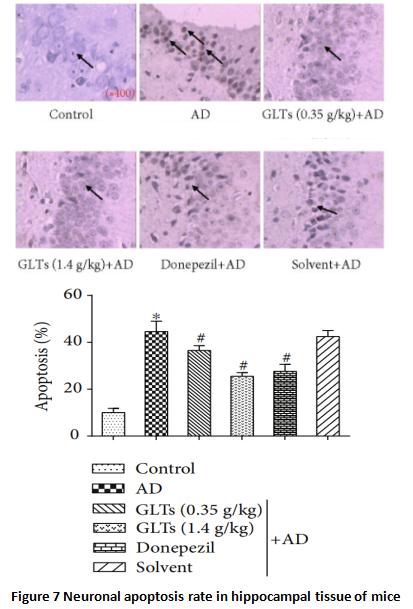
The researchers further analyzed and found that in AD mice maintained by Ganoderma lucidum triterpenoids, the brain nerve cells have a strong anti-oxidant mechanism to combat the oxidative damage caused by β-amyloid protein and the cell apoptosis mechanism is not easily activated. In other words, Ganoderma lucidum triterpenes strengthen the stress resistance of brain nerve cells, making them more able to survive and operate in a severe environment.
Ganoderma lucidum polysaccharides are also useful.
The above research results show that Ganoderma lucidum triterpenoids, after entering the gastrointestinal tract through the esophagus, can slow the progression of Alzheimer’s disease through anti-oxidation, anti-apoptosis, and anti-neurofibrillary tangles.
In fact, the effect of Ganoderma lucidum polysaccharides is not weaker than that of Ganoderma lucidum triterpenoids. In 2017, a study jointly published in “Stem Cell Reports” by Tongji University and the Chinese Academy of Sciences proved that long-term maintenance with Ganoderma lucidum water extract or Ganoderma lucidum polysaccharides can decrease β-amyloid deposits in the brains of AD mice, assist the proliferation of nerve precursor cells in the hippocampal gyrus and slows down the decline of learning and memory. (For details, see: Ganoderma lucidum polysaccharides reduce cognitive decline caused by Alzheimer’s disease)
Ganoderma lucidum triterpenoids and Ganoderma lucidum polysaccharides seem to have different effects in protecting the brain with Alzheimer’s disease. Can the combined effect of the two slow down the progression of Alzheimer’s disease?
Once Alzheimer’s disease occurs, it is difficult to reverse it. However, if we can retain more cognitive abilities, including learning and memory, in our limited life, we may have a chance to get better with Alzheimer’s disease.
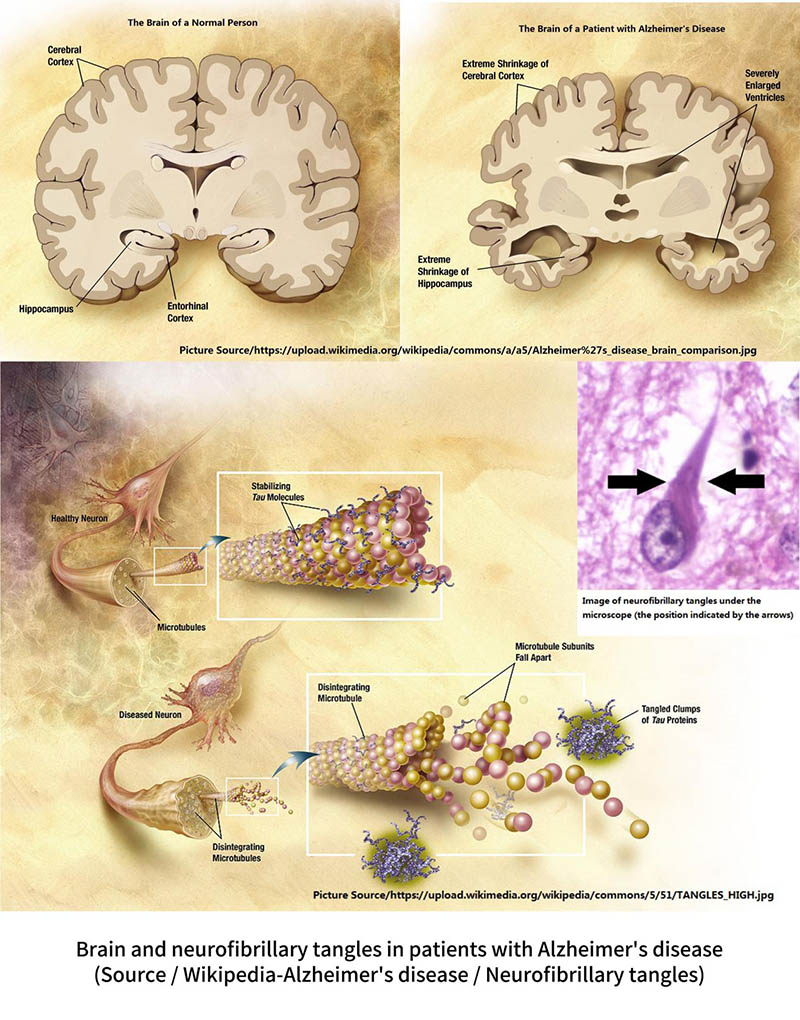
Source
1. Yu N, et al. Ganoderma lucidum Triterpenoids (GLTs) Reduce Neuronal Apoptosis via Inhibition of ROCK Signal Pathway in APP/PS1 Transgenic Alzheimer’s Disease Mice. Oxid Med Cell Longev. 2020; 2020: 9894037.
2. Huang S, et al. Polysaccharides from Ganoderma lucidum Promote Cognitive Function and Neural Progenitor Proliferation in Mouse Model of Alzheimer’s Disease. Stem Cell Reports. 2017 Jan 10;8(1):84-94. doi: 10.1016/j.stemcr.2016.12.007.
END
About the author/ Ms. Wu Tingyao
Wu Tingyao has been reporting on first-hand Ganoderma lucidum information since 1999. She is the author of Healing with Ganoderma (published in The People’s Medical Publishing House in April 2017).
★ This article is published under the exclusive authorization of the author
★ The above works cannot be reproduced, excerpted or used in other ways without the authorization of the author
★ Violation of the above statement, the author will pursue its related legal responsibilities
★ The original text of this article was written in Chinese by Wu Tingyao and translated into English by Alfred Liu. If there is any discrepancy between the translation (English) and the original (Chinese), the original Chinese shall prevail. If readers have any questions, please contact the original author, Ms. Wu Tingyao.



